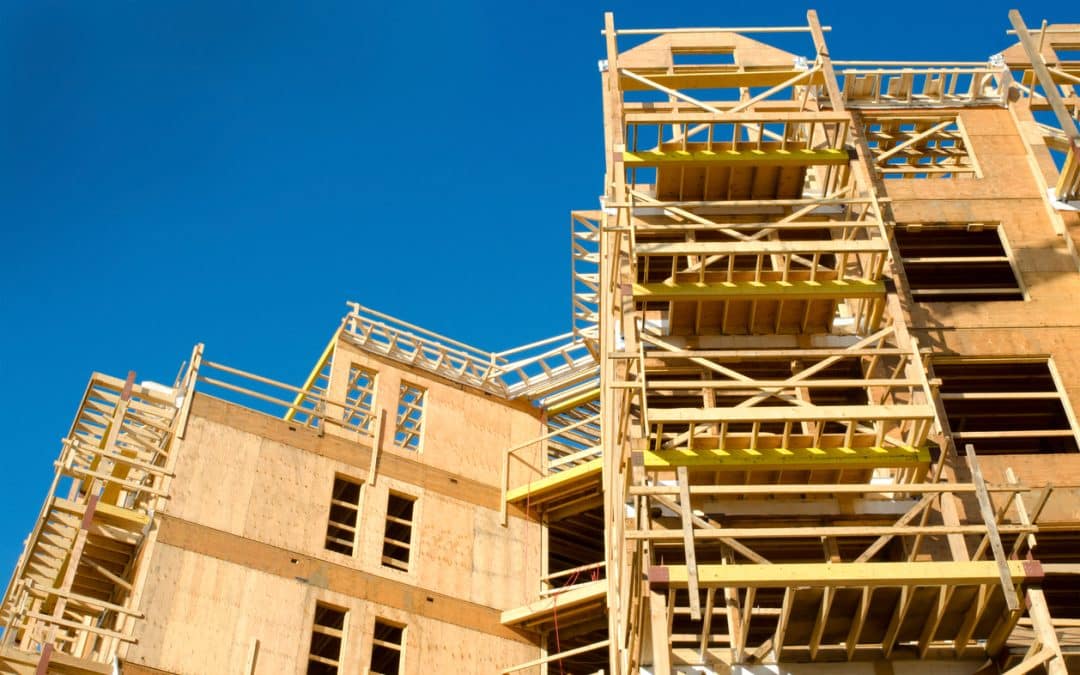James H. Schloemer is chairman of the National Multifamily Housing Council. This article is edited and adapted from prepared remarks made on behalf of the National Multifamily Housing Council and the National Apartment Association during a July 24 hearing held by the House Financial Services Subcommittee on Housing and Insurance.
Congress must prioritize increasing our nation’s housing supply and support pro-housing policies that will in turn ensure greater housing stability and affordability for renters at a variety of income levels for decades to come.
NMHC and NAA are leaders of the Housing Affordability Coalition, a broad coalition of professionals and policy experts from various parts of the real estate community committed to working together with Congress and the Administration to address America’s housing affordability crisis. In April 2024, the coalition sent a letter urging Congress to work with the Biden Administration, housing providers, lenders, and other stakeholders to pursue bipartisan solutions to increase the supply of housing in all markets and at all price points.
While there is no one silver bullet, a multifaceted approach can be effective in easing market constraints. The letter outlines bipartisan recommendations that include a combination of tax policy, regulatory reform, rental assistance, and development incentives to chip away at current affordability constraints.
Enacting these types of bipartisan proposals would have a positive impact on the housing affordability crisis and help increase the nation’s housing supply. Outlined below are policy areas that are of particular importance as the Committee looks at the housing challenges facing our nation and explores steps that policymakers can take to improve affordability and drive new supply.
Deploy the Housing Supply Action Plan
NMHC and NAA urge Congress to work with the Biden Administration to implement provisions included in the Administration’s Housing Supply Action Plan that aim to address the myriad challenges to the development of new housing, such as:
- Reward jurisdictions that have reformed zoning and land-use policies with higher scores in certain federal grant processes;
- Deploy new financing mechanisms to build and preserve more housing where financing gaps currently exist;
- Expand and improve existing forms of federal financing, including for affordable multifamily development and preservation; and
- Work with the private sector to address supply chain challenges and improve building techniques.
Reduce Barriers to Development
Rental housing providers stand ready to help meet current and future demand but cannot do so alone. Federal, state, and local policymakers also must play a role. Regulatory, administrative, and political obstacles at all levels of government prevent us from delivering the housing our country so desperately needs.
Easing regulations could go a long way to addressing the housing affordability challenges faced by communities across the nation while making critical investments in infrastructure of all types. Looking forward, we urge the Committee to support the Pro Housing Grant Program and redouble its efforts to incentivize states and localities to remove or mitigate local barriers to development of rental housing. Examples include:
- Streamline and fast track the entitlement and approval process;
- Provide density bonuses and other incentives for developers to include workforce units in their properties;
- Enable “by-right” zoning and create more fully entitled parcels;
- Defer taxes and other fees for a set period of time, including providing tax abatement;
- Lower construction costs by contributing underutilized buildings and embrace new technology driven construction advancements; and
- Encourage higher density development near jobs and transportation.
To this end, NMHC and NAA strongly support the Yes in My Backyard (YIMBY) Act (H.R. 3507/S. 1688) that Representative Flood (R-NE) has introduced with Representative Kilmer (D-WA). We applaud the Financial Services Committee for unanimously approving this bill – by a 48-0 vote – on May 16. This legislation would help eliminate barriers to development by requiring Community Development Block Grant (CDBG) recipients to report periodically on the extent to which they are removing discriminatory land use policies and promoting inclusive and affordable housing. Exclusionary land use policies like zoning and density restrictions, onerous parking requirements and other development regulations exacerbate both the housing supply and affordability crisis. We urge the full House and Congress to pass the YIMBY Act.
Return Housing and Eviction Policy Back to the State and Local Level
The Coronavirus Aid, Relief, and Economic Security (CARES) Act established a temporary 120-day moratorium on evictions due to nonpayment of rent, applicable to federally backed and federally assisted housing. This section of the CARES Act also instituted what should have been a temporary notice procedure, requiring housing providers to notify covered residents 30 days before filing for eviction after the moratorium ended on July 24, 2020.
Throughout the pandemic, rental housing professionals worked to both help residents resolve their hardships and to advance policies to provide renters with essential resources to meet their housing needs. Now that Congress and the President have terminated the federal Covid-19 public health emergency, it is time to acknowledge that the CARES Act’s 30-day notice-to-vacate requirement ended and remove the ambiguous language from federal law. We urge this Committee to support H.R. 802/S. 3755, the Respect State Housing Laws Act, returning eviction policies back to the state and local levels where they can be more effectively administered in accordance with community needs.
Fully Fund and Reform Federal Housing Support & Affordability Programs
While increasing supply is critical to the goal of addressing the Nation’s housing affordability crisis, it is equally critical to ensure that policymakers take the steps necessary to ensure assistance is available for those that simply cannot afford the housing they so desperately need. In that regard, we continue to advocate for funding for multiple critical programs that focus on housing affordability, such as the Section 8 Housing Choice Voucher Program (HCV), Project Based Rental Assistance (PBRA), Rental Assistance Demonstration (RAD), Homelessness Programs, HOME, Community Development Block Grants (CDGB), and Rural Housing programs. However, we believe that many of these programs would benefit from reform efforts to ensure the programs are operating in a cost effective and efficient manner.
Improve the Section 8 Housing Choice Voucher (HCV) Program
Since developing new housing can take some time due to the number of barriers to development, by filling the gap between the cost to provide housing and what families can afford to pay, improving the Section 8 HCV program is a crucial step to increase housing affordability in the short term. NMHC and NAA strongly support the Section 8 HCV Program, which has long served as America’s primary method for aiding 2.1 million low-income households with rental assistance. This public/private partnership helps millions of Americans find homes in communities near good schools, jobs, and transportation services, but reforms are needed to encourage and increase private-industry participation.
According to HUD’s own estimates, more than 55,000 private housing providers left the program from 2010 to 2020. To reinforce the rationales behind these significant departures, NAA recently surveyed frontline rental housing providers about their experiences, challenges, and recommendations regarding the HCV program. The survey findings revealed five key reasons why housing providers are leaving the HCV program:
- Administrative burden and paperwork requirements were the most significant challenge that led to rental housing providers leaving the HCV program;
- Burdensome, lengthy and inconsistent inspection, application and approval processes;
- Inefficient communication and a lack of timely responses from PHAs;
- Systemic issues associated with the voucher program such as liability for damages and repairs;
- Increased administrative costs to accept vouchers and increased financial strain caused by higher insurance costs attributable to accepting vouchers.
To address these concerns and bring private sector participants back to the Section 8 program, NMHC and NAA strongly support the bipartisan and bicameral Choice in Affordable Housing Act (H.R. 4606/S. 32), introduced by Ranking Member Cleaver (D-MO). This legislation includes common-sense reforms that could help improve the program for both renters and property owners and increase housing provider participation overall. Key elements include:
- Enabling public housing authorities (PHAs) to make one-time incentive payments to recruit housing providers into the program;
- Allowing PHAs to pay for security deposits for voucher holders and help mitigate housing providers’ risk of damages;
- Awarding bonus payments to PHAs that hire “landlord liaisons” to contact, recruit, retain and generally support private housing providers;
- Permitting units in buildings that have been inspected in the last year under other federal housing programs to meet the HCV inspection approval; and
- Expediting the inspection progress by creating a 60-day “pre-inspection” approval for housing providers who anticipate participating in the HCV Program.
We strongly encourage the Committee and HUD to support the Choice in Affordable Housing Act. Residents could also benefit from increased subsidies. Just as the Section 8 Housing Choice Vouchers help the neediest households cover the cost of rent to maintain their homes, security deposit subsidies can help the neediest household obtain rental housing in the first place.
Enact and Enhance Tax Policy That Promotes Housing Supply
While it will take a variety of tax and non-tax approaches to increase supply, the rental housing industry believes tax policy can play a critical role in this regard. To this end, we strongly urge Congress to:
- Expand and enhance the Low-Income Housing Tax Credit;
- Enact the Workforce Housing Tax Credit Act to support workforce housing;
- Enhance Opportunity Zones to incentivize the rehabilitation and preservation of multifamily buildings; and
- Encourage the adaptive reuse of underutilized commercial properties into multifamily housing.
Each of these proposals is briefly described below, and we note that many have bipartisan or bicameral support.
Expand and Enhance the Low-Income Housing Tax Credit
The Low-Income Housing Tax Credit (LIHTC) is a public/private partnership that leverages federal dollars with private investment to produce affordable rental housing and stimulate new economic development in many communities. Between its inception in 1986 and 2022, the LIHTC program has, according to the A Call To Invest in Our Neighborhoods (ACTION) Campaign, developed or preserved 3.85 million apartments, served 8.97 million low-income households, supported 6.33 million jobs for one year, generated $257.1 billion in tax revenue, and produced $716.3 billion in wages and income.
The LIHTC program provides critical support to the nation’s affordable housing production but could be made even more impactful.
NMHC and NAA support the Affordable Housing Credit Improvement Act of 2023 (AHCIA) (H.R. 3238 / S. 1557). Introduced by Representatives LaHood, DelBene, Wenstrup, Beyer, Tenney, and Panetta and Senators Cantwell, Young, Wyden, and Blackburn, this bipartisan bill, which is supported by a total of 34 Senators and 230 Members of the House, would, among other provisions, make permanent the now-expired 12.5 percent increase in LIHTC authority for 2018-2021 to enable the production of new units and further augment credit authority by 50%. Additionally, the bill would lower the private activity bond financing threshold to 25% from 50% required to receive the full amount of 4% LIHTC.
We also strongly support LIHTC provisions in the Tax Relief for American Families and Workers Act of 2024 (H.R. 7024), which the House on January 31 approved by a bipartisan 357-70 vote. Provisions included in H.R. 7024 would augment credit authority by 12.5 percent between 2023 and 2025, as well as reduce the private activity bond financing threshold to 30 percent from 50% in 2024 and 2025.
These provisions would create over 200,000 new multifamily units and represent a critical step toward addressing this nation’s affordable housing supply crisis. Enacting the primary unit financing provisions in the Affordable Housing Credit Improvement Act could finance up to an additional 1.94 million affordable units over 10 years. Over that period, this enhanced financing could also support nearly three million jobs, $333 billion in wages and business income, and $115 billion in additional tax revenue.
Finally, we encourage Congress to consider increasing the private activity bond volume cap to enhance the utilization of 4% LIHTC. According to February 2024 data by Tiber Hudson and Novogradac, 20 states and Washington, DC, are oversubscribed for the credit. Authorizing these states to issue additional private activity bonds would enable the financing of additional 4% LIHTC projects.
Enact the Bipartisan Workforce Housing Tax Credit Act
Housing affordability is an issue threatening the financial wellbeing of both middle-income and low-income households across the nation. According to the U.S. Census Bureau’s Survey of Market Absorption, the median asking rent for apartment units completed in the third quarter of 2023 was $1,833, a 12.23% increase from the same period in 2018. For a renter to afford one of those units at the 30% of income standard, they would need to earn at least $73,320 annually.
Furthermore, Harvard University’s Joint Center for Housing for Housing Studies reported in January 2024 that “Renter households with annual incomes of $45,000 to $74,000 have seen the fastest growth in their burden rates, both over the longer term and during the pandemic. Indeed, 41% of renter households in this income category were burdened in 2022, a 5.4 percentage point increase since the start of the pandemic, nearly doubling their 2001 rate.”
Accordingly, this is an issue impacting those workers who comprise the very fabric of strong communities nationwide, including teachers, firefighters, nurses, and police officers whose wages are not keeping pace with costs. Tax policies to spur the production of multifamily housing targeted to middle-income Americans should be a part of any legislation that seeks to address housing affordability on a comprehensive basis.
We urge Congress to enact the bipartisan and bicameral Workforce Housing Tax Credit Act (H.R. 6686 / S. 3436), sponsored by Representatives Panetta and Carey and Senators Wyden and Sullivan. This legislation establishes a new tax credit to produce affordable rental housing for households earning 100% or less of the area median income (AMI). Designed to complement the successful LIHTC program, the Workforce Housing Tax Credit (WFHTC) would enable state housing agencies to issue credit allocations to developers that would subsequently be sold to investors. Investors would receive a dollar-for-dollar reduction in their federal tax liability over a
15-year period, and developers would invest the equity raised to build apartments. The equity raised would cover 50% of the cost of constructing qualifying units. A development project eligible for WFHTC would have to set aside 60% of units for households earning 100% or less of AMI and must be kept affordable for up to 30 years.
Enhancing Opportunity Zones to Incentivize Rehabilitation of Housing Units
Enacted as part of the Tax Cuts and Jobs Act, Opportunity Zones are designed to provide tax incentives for investments in distressed communities. Opportunity Zones have held great promise for the development of multifamily housing. In fact, Novogradac in April 2024 reported that residential investment continued to be the leading investment area for Opportunity Funds. Funds tracked by Novogradac have helped finance over 175,000 homes in more than 200 cities across the United States.
Under the program, state governors have designated over 8,700 qualified low-income census tracts nationwide as Opportunity Zones, which remain in effect through 2028. Real-estate developers and others may establish Opportunity Funds to construct and rehabilitate multifamily property that are eligible for two tax incentives.
First, taxpayers may defer taxes on 0capital gains that are reinvested in Opportunity Funds to the earlier of the date an investment in an Opportunity Fund is disposed of or December 31, 2026. Notably, gains deferred for five years are eligible for a 10% basis step up, while gains deferred for seven years are eligible for an additional 5% basis step up.
Second, post-acquisition capital gains on investments held in Opportunity Funds for at least 10 years may be permanently excluded from income. While taxpayers may continue to invest capital gains in Opportunity Funds through June 28, 2027, it is already too late to meet requirements for a step up in basis attributable to newly deferred capital gains.
In addition, the economy has changed since Opportunity Zones were originally designated shortly after the enactment of TCJA. Opportunity Zones can be a helpful tool to incentivize housing production and, thereby, assist in addressing the nation’s housing affordability crisis.
However, to maximize the full potential of Opportunity Zones, Congress should:
- Enable states to recertify and/or redesignate Opportunity Zones to account for current economic realities and changes since zones were originally designated; and
- Establish new investment deadlines so that taxpayers are incentivized to receive both a longer deferral period and the potential for the 10-percent or 15-percent basis increase with respect to reinvested capital gains.
While Opportunity Zones are beneficial for new multifamily development, developers may find it difficult to use Opportunity Zone benefits to rehabilitate existing properties. To qualify for Opportunity Zone benefits for renovations, the basis of an existing asset must be doubled, excluding the value of any land.
Although property that is added to and improves an asset can count toward this threshold, doubling the basis can still be a high hurdle. Accordingly, Congress should reduce the basis increase necessary to qualify a multifamily rehabilitation project for Opportunity Zone purposes.
Encouraging the Adaptive Reuse of Underutilized Commercial Properties into Multifamily Housing
Given the nation’s shortage of affordable rental housing, many developers are considering turning unused and underutilized commercial real estate, including offices, hotels, and retail spaces into housing. Not only would such repurposing help address the nation’s housing supply challenge, but it would also create jobs and boost local property tax revenues and economic growth.
A segment of commercial real estate space could potentially be available to be converted into affordable housing. A February 2023 Urban Land Institute study commissioned by the NMHC Research Foundation provided case study examples of successful conversions, and several large jurisdictions, including Washington, DC, and New York City, have recently embarked on plans to incentivize office-to-residential conversions.
Changing consumer preferences and online shopping are also changing the real estate landscape. Estimates show between several hundred million and 1 billion square feet of surplus and obsolete retail space. Slower post-pandemic business travel is also challenging a portion of the nation’s hotel stock.
Unfortunately, converting commercial real estate into housing can be extremely challenging and can be more complicated than typical ground-up development. Costs associated with property acquisition and conversion, including addressing structural building issues (e.g., beams, columns, ceiling heights, utilities, and floor layouts), can quickly add up and make the difference between a viable or unfeasible project. This is in addition to other barriers that may arise, including permitting, zoning rules, and NIMBYISM.
A Federal tax incentive to encourage property conversions would be greatly beneficial in helping to overcome these obstacles and spurring additional housing supply. In addition, it would help revitalize distressed commercial property and stabilize the surrounding communities. Notably, Representatives Carey and Gomez and Senators Stabenow, Brown, Peters, and Padilla on July 11 introduced the Revitalizing Downtowns and Main Streets Act (H.R. 9002 / S. 4693) that would establish a temporary and allocated 20% tax credit to convert commercial property into residential use. NMHC and NAA strongly support this legislation.
Conclusion
This is the bottom line: there is no silver bullet, but a multi-faceted approach to improving housing affordability and increasing housing supply is our best bet. The health and stability of the rental housing sector is paramount to that of our overall economy. And, importantly, the sufficient supply of quality housing is necessary in ensuring the continued economic prosperity and household stability for Americans nationwide. Without it, we put both at risk. Solving this challenge should be mission critical for Congress.














Easy. Do not do anything that blue states do. Especially California. Ease the cost and red tape on construction and DROP THE PRICES